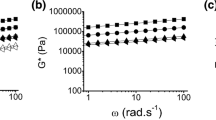Abstract
Four types of Altamura bread, obtained by using semolina from four pure durum wheat cultivars (Appulo, Arcangelo, Duilio and Simeto), were prepared and compared to evaluate the influence of durum wheat cultivar on the sensory properties and staling rate of the final product. Pure semolina samples showed marked differences in chemical and rheological properties, with semolina from cv. Simeto characterised by higher protein content, alveograph data (tenacity/extensibility ratio and deformation energy) and rate of hydration at the farinograph test. The durum wheat cultivar seemed to significantly affect staling rate, as determined by crumb water loss and firming, the bread from cv. Simeto showing a markedly lower crumb moisture loss and firming than the other breads during 8 days of storage. On the other hand, the sensory profile of bread was scarcely affected by durum wheat cultivar; among the 19 sensory descriptors defined to describe differences between bread samples, only crumb colour, grain and humidity, and crust crispness showed significant differences.
Similar content being viewed by others
References
Official Journal of the European Communities (2001) C 156, vol. 44, 30 May 2001 (pp.10–15). (2001/C 156/04)
Quaglia G (1988) Other durum wheat products. In: Fabriani G, Lintas C (eds) Durum wheat: chemistry and technology. American Association of Cereal Chemistry, St. Paul, Minn., pp 263–274
Chang CY, Chambers E (1992) Cereal Chem 69:556–559
Lotong V, Chambers E, Chambers DH (2000) J Sensory Stud 15:309–326
Corsetti A, Gobbetti M, Balestrieri M, Paoletti F, Russi L, Rossi J (1998) J Food Sci 63:347–351
Boyacioglu MH, D’Appolonia BL (1994) Cereal Chem 71:34–41
Comendador FJ, Sinesio F, Paoletti F, Moneta E (2001) Tec Molitoria 52:1208–1219
Hareland GA, Puhr DP (1998) Cereal Chem 75:830–835
Boggini G, Pagani MA, Lucisano M (1997) Tec Molitoria 48:781–791
Pasqui LA, Carcea M, Paoletti F, Cubadda R (1994) Tec Molitoria 45:223–228
Boggini G, Tusa P, Pogna NE (1995) J Cereal Sci 22:105–113
American Association of Cereal Chemistry (2000) Approved methods of the American Association of Cereal Chemistry, 10th edn. AAAC, St. Paul, Minn.
Dick JW, Quick JS (1983) Cereal Chem 60:315–318
D’Egidio MG, Mariani BM, Nardi S, Novaro P, Cubadda R (1990) Cereal Chem 67:275–281
ISO 13299 (1998) Sensory Analysis. Methodology. General guidance for establishing a sensory profile. International Organisation for Standardisation, Geneva, Switzerland
ISO 8585–1 (1994) Assessor for Sensory Analysis. Part 1. Guide to the Selection, Training and Monitoring of the Selected Assessors. International Organisation for Standardisation, Geneva, Switzerland
ISO 8585–2 (1994) Assessor for sensory analysis. Part 2. Guide to the selection, training and monitoring of experts. International Organisation for Standardisation, Geneva, Switzerland
Boyacioglu MH, D’Appolonia BL (1994) Cereal Chem 71:21–28
Peña RJ (2000) Options Méditerr 40:423–430
Borghi B, Corbellini M, Minoia C, Palumbo M, Di Fonzo N, Perenzin M (1997). Eur J Agron 6:145–154
Spina A, Boggini G, Palumbo M, Romano E (2001) Tec Molitoria 52:788–792
Kunerth WH, D’Appolonia BL (1985) Use of the mixograph and farinograph in wheat quality evaluation. In: Faridi H (ed) Rheology of wheat products, American Association of Cereal Chemistry, St. Paul Minn., p 27
Crowley P, Schober TJ, Clarke CI, Arendt EK (2002) Eur Food Res Technol 214:489–496
Fontanet I, Davidou S, Dacremont C, Le Meste M (1997) J Cereal Sci 25:303–311
Hayman DA, Hoseney RC, Faubion JM (1998) Cereal Chem 75:581–584
Pyler EJ (1988) Baking science and technology, vol. II. Sosland, Merriam, Kan., pp 815–849
Rogers DE, Zeleznak KJ, Lai CS, Hoseney RC (1988) Cereal Chem 65:398–401
Kim SK, D’Appolonia B (1977) Cereal Chem 54:216–222
Maleki M, Hoseney RC, Mattern PJ (1980) Cereal Chem 57:138–140
Martin ML, Zeleznak KJ, Hoseney RC (1991) Cereal Chem 68:498–503
Acknowledgements
We are indebted to Mr. Giuseppe Barile for accurate breadmaking, and to Tiziana Catone, Elisabetta Moneta and Nicoletta Nardo for technical assistance. The authors equally contributed to the realisation of this work.
Author information
Authors and Affiliations
Corresponding author
Rights and permissions
About this article
Cite this article
Raffo, A., Pasqualone, A., Sinesio, F. et al. Influence of durum wheat cultivar on the sensory profile and staling rate of Altamura bread. Eur Food Res Technol 218, 49–55 (2003). https://doi.org/10.1007/s00217-003-0793-1
Received:
Published:
Issue Date:
DOI: https://doi.org/10.1007/s00217-003-0793-1




